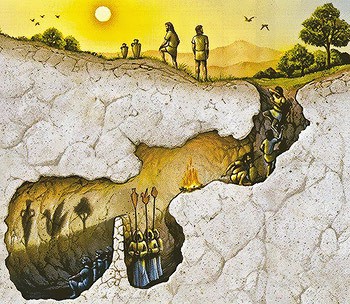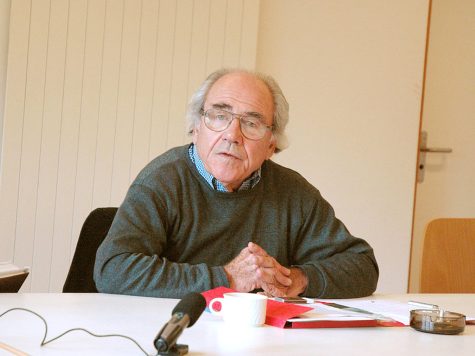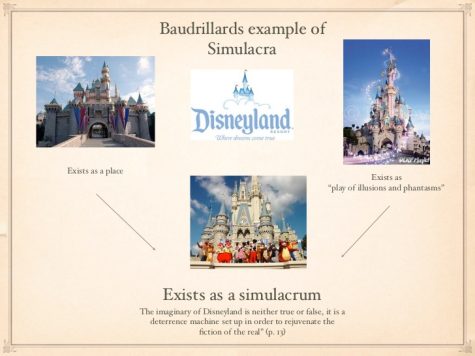Cave Allegory and Simulation
From Plato to Baudrillard
The purpose of this article is to give an account of Plato’s Allegory of the Cave, and then show, through Baudrillard’s ideas of simulation and hyperreality, that it is unusable. The first part can serve as a general introduction to Plato’s concept of Forms, while the second part can also serve as an introduction to Baudrillard’s Simulacra and Simulation.
I: The Allegory
In Plato’s Republic, there is a famous allegory in which Plato describes prisoners chained up in a cave, their backs pushed up to a wall. The prisoners have been there since childhood, and have known nothing else. Behind this wall is a raised fire, and an area where the guards stand. The guards hold up statues and figures of all kinds on the wall, making shadows for the prisoners to see. Plato writes, “To them, I said, the truth would be literally nothing but the shadows of the images” (Plato 503). The prisoners will believe the shadows on the wall of the cave are real objects, and voices in the background would belong to those objects.

Then, Plato describes if a prisoner was liberated. They would feel pain from the light of the sun in their eyes, and they would be perplexed. The prisoner will know that before, in the cave, what he saw were illusions. He will have a hard time believing those who tell him that the images on the wall were just shadows, and the objects lighted by the sun are what is real.
Eventually, the freed man will grow accustomed to the sight of objects and take them to be real. At first reflections on the water and shadows he will see best, and then eventually objects themselves, the light of the sun, and eventually the sun he will see best. Plato writes, “. . . and you will not misapprehend me if you interpret the journey upwards to be the ascent of the soul into the intellectual world . . .” (506).
To Plato, there is some innate knowledge, and that the capacity to learn is inherent: “But then, if I am right, certain professors of education must be wrong when they say that they can put a knowledge into the soul which was not there before, like sight into blind eyes” (507).
Plato believes that separated from this world of sight, there are these abstract things called Forms, which are never changing and eternal; they are the highest kinds of reality. For Plato, goodness is the most important Form.
The cave allegory shows that by seeking to study and gain more knowledge through thought, people can become enlightened and reason out the Forms.
II: Simulation
French philosopher Jean Baudrillard is famous for concepts he wrote about in his 1981 book, Simulacra and Simulation.

In it, Baudrillard states that simulation threatens the difference between concepts as fundamental as truth and falsehood, reality and imagination. It is important to note that Baudrillard diverges from an account of just mere copies, parodies, and duplications; he talks about substituting for the real even more real. Hence we get his theory of hyperreality.
A famous example of this is Disneyland, where everything is made to look perfectly real, with full-size houses and castles. He writes,
Disneyland is presented as imaginary in order to make us believe that the rest is real. Whereas all of Los Angeles and the America that surrounds it are no longer real, but belong to the hyperreal order and to the order of simulation. It is no longer a question of false representation of reality (ideology) but of concealing the fact that the real is no longer real, and thus saving the reality principle. (Baudrillard 12)
To understand more of what he means by simulation, we must first understand what he calls the “phases of the image.” They are as follows:
it is the reflection of a profound reality;
it masks and denatures a profound reality;
it masks the absence of a profound reality
it has no relation to any reality whatsoever: it is its own pure simulacrum. (6)
Thus Disneyland masks the absence of reality, in showing that there is one area, here, that is imaginary (Disneyland), and everything else (Los Angeles, America, the World), that is real.

Disneyland is therefore a simulation of the third order. Baudrillard argues that there is no such distinction.
Understanding Baudrillard’s idea of simulacra is also vital to understanding his philosophy. The simplest definition of simulacra is a real without origin or reality or a copy without an original.
In our day of advanced technology and cybernetics, it is not hard to think of simulacra. Let’s consider the romanticized idea of The Wild West. When we think of The Wild West, we think of cowboys, natives, and outlaws. This has no relation to a discernible reality. This is the product of ‘mediated images,’ and yet this is what everybody thinks of when one talks about that time period of American history.
Baudrillard levels his arguments on many disciplines and ideas, but especially the media. He believes that there is “more and more information, and less and less meaning” (79). His arguments have been grouped with the diverse group of theorists known as postmodernists. He is said to be one of the great prophets of postmodernity. These theorists, in general, dismantle grand narratives of the past. So what about Plato?
III: Conclusion
Given Baudrillard’s ideas of hyperreality and simulation, it is evident that the cave allegory is unusable in its original form. In my opinion, Plato’s notion that some privileged philosophers can leave this cave and shed the realm of representation and illusion is wrong. Nobody can leave the cave.

This is part of the reason why Baudrillard did not like the film The Matrix, even though it was largely a tribute to his philosophy. He did not like it because the characters could leave the realm of simulation and enter into a ‘real’ world. This is obviously against the tenets of simulation. He writes, “Whereas representation attempts to absorb simulation by interpreting it as a false representation, simulation envelops the whole edifice of representation itself as a simulacrum.” (6) Therefore, it is impossible to differentiate, and Plato’s realm of representation is enveloped by simulation and constructed by simulacrum. The Matrix is in effect much more like Plato’s allegory of the cave than Simulacra and Simulation. According to Baudrillard, the simulacra has nothing underneath, thus discrediting Plato’s idea of Forms as well.
The simulacrum is never what hides the truth – it is truth that hides the fact that there is none.
The simulacrum is true.
– Ecclesiastes
Sources
A. “Simulacra.” a03blog, 6 Dec. 2016, https://a03blog.wordpress.com/2016/11/23/simulacra/.
Baudrillard, Jean, and Sheila Faria Glaser. Simulacra and Simulation. The University of Michigan Press, 2020.
Catherine, et al. “Plato’s Allegory of the Cave.” Catherinebanksdiac.wordpress.com, 6 Mar. 2018, https://catherinebanksdiac.wordpress.com/2018/03/06/platos-allegory-of-the-cave/.
David Kipping Assistant Professor of Astronomy at Columbia University, et al. “Can We Know If Our Universe Is a Simulation?” Polytechnique Insights, 26 Aug. 2021, https://www.polytechnique-insights.com/en/columns/science/can-we-know-if-our-universe-is-a-simulation/.
“Hyperreality.” Wikipedia, Wikimedia Foundation, 1 Aug. 2021, https://en.wikipedia.org/wiki/Hyperreality.
Ltd, All Answers. “Plato’s Theory of Knowledge.” UK Essays, UK Essays, 12 Aug. 2021, https://www.ukessays.com/essays/philosophy/plato-the-theory-of-knowledge-philosophy-essay.php.
Mboma, Aaron. “On Plato’s ‘Allegory of the Cave’.” Medium, Medium, 18 June 2019, https://medium.com/@aaronmboma/on-platos-allegory-of-the-cave-49d03eb49cb1.
Plato. Republic. Translated by B. Jowett, AmazonClassics, 2017.
Post – Sociology. http://sociology.org.uk/notes/pcpmod.pdf.
Travis, Ben. “The Matrix Sequels Explained: What Actually Happened in Reloaded and Revolutions?” Empire, Empire, 16 Sept. 2021, https://www.empireonline.com/movies/features/matrix-sequels-explained-what-happens-in-reloaded-revolutions/.
